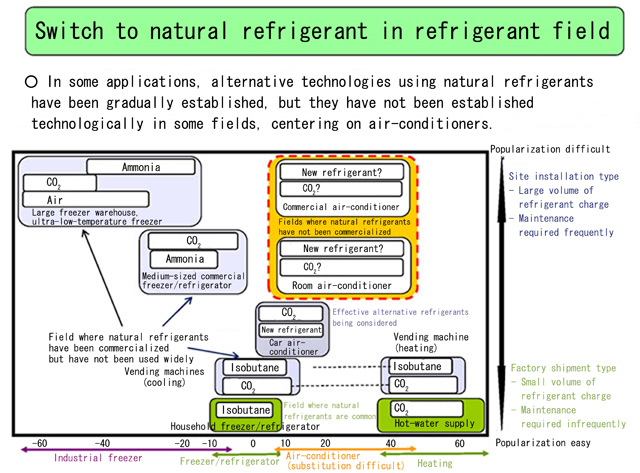Technology
Main characteristics of natural refrigerants

- Ammonia (NH3, R717)
- Ammonia is a refrigerant consisting of nitrogen and hydrogen. From the latter half of 1800s to the development of CFCs, ammonia had been widely used as a refrigerant. It can still be used as a freezing/refrigerating device in industries. R717 is a chemically stable substance but reacts when it comes into contact with CO2 or copper. It is compatible with steel materials and appropriate refrigeration oils. The pressure-temperature characteristics of R717 are similar to those of R22. It has higher thermal conductivity than R22. As R717 is toxic and flammable, it is classified into the safety category of type B2. However, unlike CFCs, it does not affect the ozone layer and has zero GWP; hence, it is an eco-friendly refrigerant. R717 is very inexpensive and easily available.
- Hydrocarbons (HCs)
- Hydrocarbon is a refrigerant consisting of hydrogen and carbon. Most commonly used for freezing purposes are isobutane (C4H12, R600a), propane (C3H8, R290), propylene (C3H6, R1270) and their mixtures. Other HCs are also used. HCs had been used as a refrigerant in the latter half of 1800s, and are started to be used again from the beginning of 1990s. Domestically, HCs were used in freezers, commercial freezers, air-conditioners, and chillers, putting aside industrial applications. HCs are chemically stable and has similar compatibility to CFCs and HCFCs. Depending on its type, HCs have various pressure-temperature characteristics and excellent thermodynamic characteristics and transportation characteristics. Potentially, it can make a very efficient system. HCs are very highly flammable; hence, all of HCs are classified into safety category of A3. As with R717, they do not affect the ozone layer and have a negligible GWP. R600a and R290 are very inexpensive.
- Carbon dioxide (CO2, R744)
- Carbon dioxide contains carbon and oxygen and is widely used in various industries. CO2 had been widely used as a refrigerant since the middle of 1800s. However, with the advent of CFCs and HCFCs, its popularity declined as well. From the latter half of 1990s, it started to be used again, and is increasingly used in the range of industrial freezers, refrigerators, commercial freezers, and hot water systems. R744 is chemically stable. It does not react under most situations and is compatible with many materials. However, it is different from conventional refrigerants in that it has 7 times as high pressure characteristics as R22. Therefore, it requires a design that give special considerations to high pressure. In addition, its low critical temperature requires a special system design if the ambient temperature can be +25°C or higher. It has excellent characteristics and therefore can be a very efficient system in cold areas. CO2 is classified into A1 due to its low toxicity and non-flammability. It does not affect the ozone layer but has a GWP of 1. R744 is very inexpensive and easily available.
Retrofiting method

*For details in retrofitting of each refrigerant, contact us.